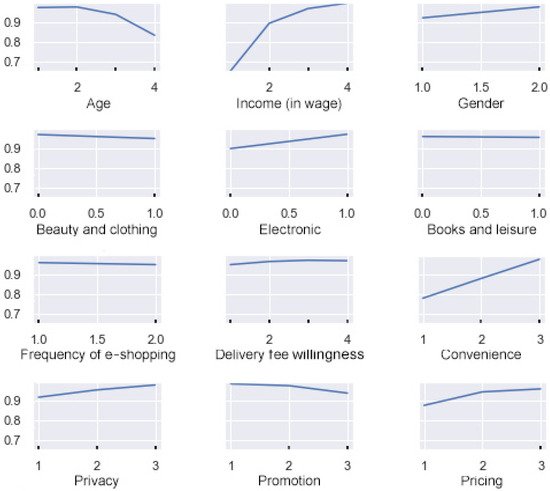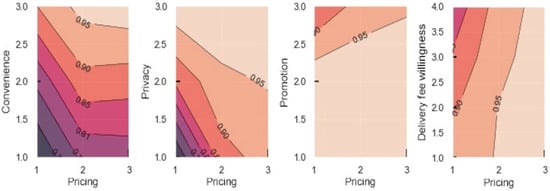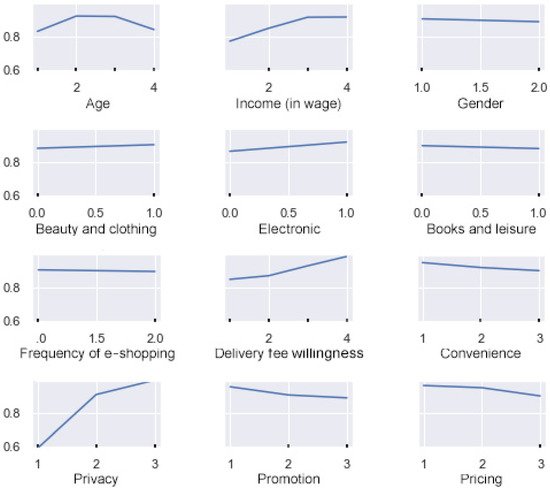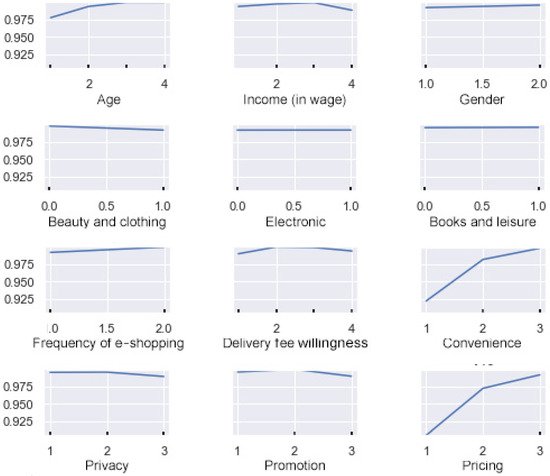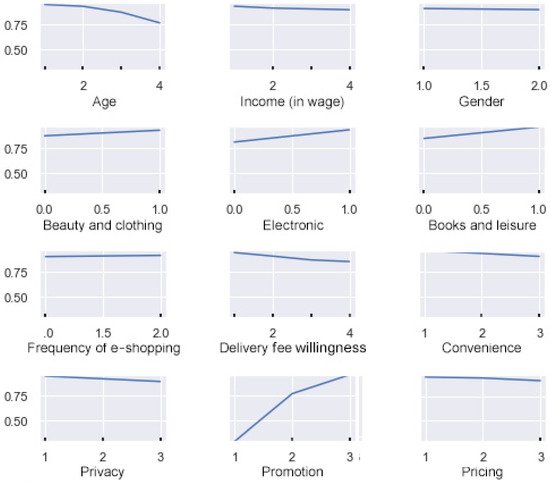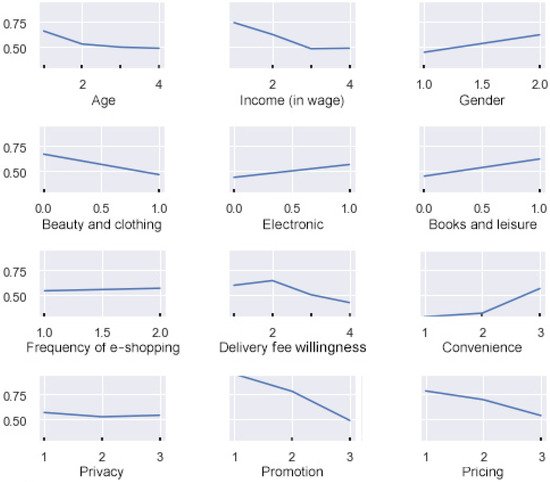E-consumer behaviour plays a vital role in e-commerce worldwide. This entry addresses the importance of delivery time, delivery fee, and delivery reception, and the influence of delivery fee and reception on e-consumers’ behaviour by analysing the following hypotheses: delivery attributes affect e-shopping behaviour, and delivery attributes affect e-consumers’ behaviour according to their sociodemographic characteristics. Data were obtained from a web-based survey with Brazilian e-consumers, and logistic regression and artificial neural network models were estimated to assess consumer behaviour.
1. Introduction
The Internet has contributed to the expansion of e-commerce as online personalised purchases have increased considerably in the last decades. From all sales worldwide, e-commerce sales account for 18%. China was the world leader in e-commerce sales in 2020, and the highest percentage growth was observed in Argentina
[1]. Brazil and Mexico were the Latin-American leaders in 2020, with 31% and 28%, respectively
[1]. Moreover, US$ 112.4 billion were spent in the online market in Brazil, followed by Mexico (31.5 billion) and Colombia (14.5 billion in 2020)
[1]. Fashion, shoes, and cosmetics are the leading product categories among Brazilian shoppers. This paper addressed e-commerce in Brazil, an emergent market, which reached 8% of total sales in 2020.
The demand for delivery services has increased due to online shopping
[2]. However, the increase of business-to-consumer (B2C) deliveries has worsened urban freight-related problems, such as negative impacts on traffic and pollution and urban mobility reduction
[2]. B2C deliveries benefit from the high demand in urban cities
[3], although these services generally consider just one package per delivery, thus not allowing for economies of scale
[4].
Despite the growth of e-commerce in the Brazilian market, few studies have analysed the impacts of e-commerce deliveries. The focus is usually on the assessment of sustainable last-mile alternatives. Nogueira et al.
[5] analysed the awareness of e-consumers for sustainable last-mile delivery decisions and Oliveira et al.
[6] analysed the demand for pick-up points as a sustainable solution for last-mile deliveries. However, the factors influencing delivery services should be known to fulfil customers’ expectations and needs
[3]. The most common delivery factors reported in the literature are delivery time
[5][7][8][9], delivery reception, and return possibility
[7]. Nonetheless, e-consumer behaviour plays a vital role in e-commerce
[10], once urban freight policies and practices require understanding how the e- consumers react to it
[11]. Therefore, understanding e-consumer behaviour is key to solving the last-mile problem.
The literature related to the effects of e-commerce delivery attributes on consumer behaviour is limited and focuses on supply chain management
[12] and e-commerce purchases
[8]. Moreover, some research shows delivery’s influence on e-shopping
[13][14][15][16]. More specifically, short delivery times influence e-shopping decisions
[12]. Furthermore, Amorim et al.
[17] found that delivery time, delivery reception, and the flexibility of delivery reception are critical attributes that considerably influence customer preferences for home deliveries of e-grocery products.
The research question addressed in this paper is how delivery attributes affect e-consumers’ behaviour. More specifically, we aim to analyse the effects of delivery attributes (delivery time, delivery fee, and delivery reception) on e-shopping consumer behaviour. Firstly, we estimated a regression model to identify which factors related to e-shopping consumer behaviour related to the delivery attributes. Next, we used artificial neural networks to identify patterns regarding the effects of delivery attributes on e-shopping consumer behaviour. The use of these techniques brings novelty to this study since the usual approaches found in the literature are discrete choice modelling
[6][7][8][9][18][19][20][21][22], conjoint analysis
[8], cluster analysis
[8][23], the mixed structural equation model
[10], and statistical tests
[5].
Thus, the contribution of this paper is threefold. Firstly, we evaluated the effects of delivery attributes on e-shopping consumer behaviour. Second, we used alternative methods to analyse e-customers behaviour. Finally, we analysed the consumer behaviour in e-commerce in an emerging market, where the number of studies is still minimal
[24]. Findings support the development of sustainable delivery strategies. Most e-commerce deliveries are destined for the home/workplace of the buyer. While strategies such as pick-up points are still incipient in Brazil
[18], the absence of strategies to meet home delivery needs efficiently is unsustainable in the long term with the growth of e-commerce and the increasing number of orders, and thus the number of deliveries, by the free shipping strategy
[25]. Therefore, it is essential to identify how delivery attributes have influenced e-consumer behaviour in this context.
2. Significance of the Effects of Delivery Attributes on E-consumption Behaviour
Table 1 presents the estimated coefficients of the logistic regression model and the significance of the estimations. The variable with statistical significance shows that the delivery attributes somehow affect the e-consumer.
Table 1. Results of the logistic regression models.
| Variables |
Range |
Importance of Delivery Time |
Importance of Delivery Fee |
Importance of Delivery Reception |
Influence of Delivery Fee |
Influence of Delivery Reception |
| Intercept |
−3.21 *** |
−2.24 |
−2.00 ** |
18.72 |
2.06 ’ |
| Sociodemographic characteristics |
Age |
25−34 years |
−0.48 |
−0.63 |
−0.18 |
−1.14 |
−0.13 |
| 35−49 years |
−0.09 |
0.36 |
0.65’ |
−2.87 ** |
−0.26 |
| >50 years |
−0.64 |
−0.57 |
−0.09 |
−3.21 ** |
0.726 ’ |
| Income |
2–4 wages |
0.61 |
−1.58 |
0.48* |
1.23 |
−0.11 |
| 4–10 wages |
0.87 |
−0.69 |
0.76 |
1.27 |
−0.36 |
| >10 wages |
0.64 |
−1.50 |
0.88 |
0.86 |
0.36 |
| Gender |
Female |
0.92 ** |
0.89 ’ |
0.54 ** |
0.04 |
0.05 |
| E-consumption behaviour |
Product type |
Beauty and clothing |
−0.27 |
−0.24 |
0.11 |
−0.07 |
−0.22 |
| Electronic products |
−0.73 |
−0.42 |
−0.31 |
1.92 * |
−0.13 |
| Books and leisure products |
0.26 |
1.03 * |
−0.48 * |
0.05 |
−0.03 |
| E-shopping frequency |
> than once by month |
−0.18 |
0.36 |
−0.48 * |
0.41 |
−0.27 |
| Delivery fee willingness to pay |
Until 7% |
−0.69 |
0.27 |
−0.29 |
−0.09 |
0.24 |
| Until 10% |
−0.70 |
−0.24 |
−0.15 |
−0.48 |
0.43 |
| >10% |
−1.07 * |
−0.88 |
0.07 |
−0.29 |
0.61 * |
| E-shopping characteristics |
Convenience |
Neutral |
0.19 |
0.27 |
0.10 |
1.39 |
0.60 |
| Important |
0.52 |
−0.24 |
−0.33 |
0.55 |
0.40 |
| Privacy |
Neutral |
0.55 |
−0.55 |
1.19 *** |
0.52 |
0.10 |
| Important |
1.42 ** |
1.21 ** |
1.28 * |
0.33 |
0.67 ** |
| Promotion |
Neutral |
1.97 |
18.11 |
−0.28 |
−2.39 ** |
−0.39 |
| Important |
0.65 |
1.65 ** |
0.20 |
−1.06 |
−0.24 |
| Pricing |
Neutral |
19.51 |
21.32 |
2.59 ** |
−15.97 |
−1.72 |
| Important |
4.37 * |
5.13 * |
2.09 ** |
−15.62 |
−1.54 |
| Accuracy |
|
|
91% |
94% |
73% |
93% |
73% |
Results show that characteristics such as delivery fee willingness to pay, and privacy are affected by delivery times according to gender. Similarly, delivery fees affect the e-consumer according to gender, the habit of purchasing books and leisure products, privacy, promotions, and pricing, and also influence the e-shopping decision by age, purchase of electronic products, and promotions. In addition, delivery reception is considered by respondents according to their age, income, gender, frequency of e-shopping, privacy, and pricing. Finally, delivery fee, willingness-to-pay, and privacy are characteristics influenced by delivery reception on the e-shopping decision.
3. Pattern Recognition
The following sections present the PDPs to recognise patterns related to the effects of sociodemographic characteristics, e-consumption behaviour, and e-shopping characteristics on the different delivery attributes. The effects are analysed and compared considering four patterns: increase, decrease, constant, and complex.
3.1. Importance of Delivery Time
Figure 1 shows the variable patterns related to the importance of delivery time on e-shopping. Increasing patterns are observed for income, gender, purchase of electronic products, delivery fee willingness to pay, convenience, privacy, and pricing. It suggests that such characteristics are important when delivery times are considered in e-shopping. Conversely, age, some products (beauty and clothing) and promotion are not essential when the effects of the delivery time are considered. Finally, shopping books, leisure products and the frequency of e-shopping are not affected by delivery times.
Figure 1. Pattern recognition for the importance of delivery time on e-shopping.
Figure 2 shows the marginal effects of e-shopping characteristics regarding the importance of delivery time. The pricing e-shopping characteristic is taken as a baseline for comparison. In the different charts, vertical lines indicate that the other variable is more important than pricing considering this delivery attribute. Horizontal lines indicate that the other variable is less critical than pricing for this delivery attribute. Finally, ascending or descending curves with 45-degree or 135-degree slopes (concerning the bottom left corner) indicate that both variables (i.e., the other variable and pricing) have the same importance for this delivery attribute. Therefore, convenience, privacy and promotion are less important than pricing, while delivery fee willingness-to-pay is more relevant than pricing.
Figure 2. Analysis of marginal effects of the importance of delivery time: comparison between pricing, convenience, privacy, promotion, and delivery fee willingness-to-pay.
3.2. Importance of Delivery Fee
Figure 3 shows the pattern analysis for the importance of delivery fees. The analysis by age resulted in a complex pattern with a concave curve: it increases until the 25–34-year-old category (class 2), remains constant, and decreases after the 35–49-year-old category (class 3). Income, electronic products, delivery fee willingness to pay, and privacy showed increasing patterns, indicating that these variables positively correlated to delivery fee when e-shopping. However, decreasing patterns are observed for convenience, promotion, and pricing, and thus presented negative effects when the importance of delivery fees is analysed. Finally, constant patterns are observed for gender, beauty and clothing products, books and leisure products, and frequency of e-shopping, which suggest their irrelevance regarding the effects of delivery fees.
Figure 3. Pattern recognition for the importance of delivery fee on e-shopping.
According to the PDPs of Figure 4, convenience and promotion are less relevant than pricing regarding the importance of delivery fees. In contrast, privacy and delivery fee willingness-to-pay are more relevant than pricing for this delivery attribute.
Figure 4. Analysis of marginal effects of the importance of delivery fee: comparison between pricing, convenience, privacy, promotion, and delivery fee willingness to pay.
3.3. Importance of Delivery Reception
Figure 5 shows the pattern analysis for the importance of delivery reception. Age, frequency of e-shopping, delivery fee willingness to pay, convenience, and pricing showed increasing patterns; thus, they are positively affected when the importance of delivery reception is assessed. Conversely, income, gender, beauty and clothing products, privacy, and promotion presented decreasing patterns, thus presenting adverse effects when the delivery reception is considered. Finally, flat patterns are observed for electronics and books and leisure products, which indicates that they are not considered when delivery reception is analysed.
Figure 5. Pattern recognition for the importance of delivery reception on e-shopping.
The PDPs of Figure 6 show that privacy, promotion, and delivery fee willingness-to-pay are less relevant than pricing according to the importance of delivery reception. On the other hand, convenience and pricing are equally likely related to e-consumption when the importance of delivery reception is assessed.
Figure 6. Analysis of marginal effects of the importance of delivery reception: comparison between pricing, convenience, privacy, promotion, and delivery fee willingness to pay.
3.4. Influence of Delivery Fee
Figure 7 shows the pattern analysis of how the delivery fee influences the e-shopping decision. The characteristics are of gender and frequency of e-shopping are not considered when that delivery attribute is assessed. Beauty and clothing, electronics, books and leisure products, and promotion are positively correlated to the influence of e-shopping. In contrast, age, income, delivery fee willingness-to-pay, convenience, privacy, and pricing showed decreasing patterns; thus, they are negatively correlated to the delivery fee influence on the e-shopping decision.
Figure 7. Pattern recognition for the influence of the delivery fee on the e-shopping decision.
For the influence of delivery fee on the e-shopping decision, the PDPs of Figure 8 show that convenience, privacy, and delivery fee willingness-to-pay have similar importance compared to pricing. In addition, promotion is more important than pricing when compared to the influence of the delivery fee.
Figure 8. Analysis of marginal effects of the influence of delivery fee on the e-shopping decision: comparison between pricing, convenience, privacy, promotion, and delivery fee willingness to pay.
3.5. Influence of Delivery Reception
Figure 9 shows the marginal effects of how the delivery reception influences the e-shopping decision. The frequency of e-shopping has a flat pattern, which indicates no effects for this delivery attribute. Gender, electronic products, book and leisure products, and convenience showed increasing patterns and thus the positive effects of such characteristics. In contrast, age, income, beauty and clothing, delivery fee willingness-to-pay, privacy, promotion, and pricing resulted in decreasing patterns, representing negative effects for the influence of delivery reception on the e-shopping decision.
Figure 9. Pattern recognition to evaluate the influence of delivery reception on the e-shopping decision.
Figure 10 shows that privacy and promotion are more important than pricing. At the same time, convenience and delivery fee willingness-to-pay have the same importance as pricing for the influence of delivery reception on the e-shopping decision.
Figure 10. Analysis of marginal effects of the influence of delivery reception on the e-shopping decision: comparison between pricing, convenience, privacy, promotion, and delivery fee willingness to pay.

